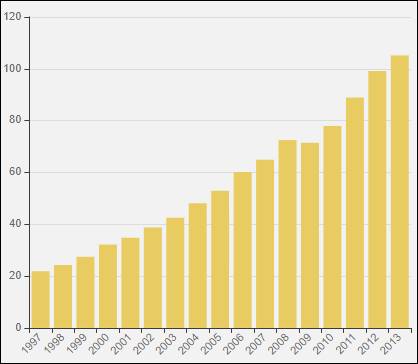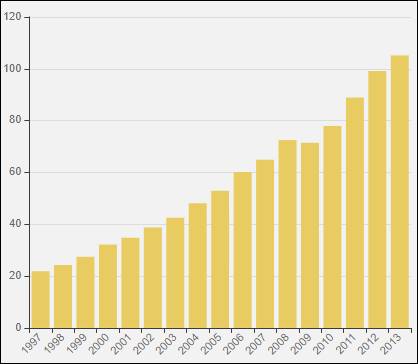
Precalculus with Limits: A Graphing Approach
7th Edition
ISBN: 9781305071711
Author: Ron Larson
Publisher: Brooks/Cole
expand_more
expand_more
format_list_bulleted
Question
Chapter B.1, Problem 14E
To determine
To graph:
Bar graph for the given data.
Expert Solution & Answer
Answer to Problem 14E
The bar graph for the given data is as below:

Explanation of Solution
Given information:
| Year | Precipitation |
Graph:
Consider the provided data of Costco wholesale stores in the year of
The bar graph for the given data is as below:

Interpretation:
So according to the above bar graph it is observed that, as the year increases from of
And then revenues for the Costco wholesale stores decrease in the year
Chapter B Solutions
Precalculus with Limits: A Graphing Approach
Ch. B.1 - Prob. 1ECh. B.1 - Prob. 2ECh. B.1 - Prob. 3ECh. B.1 - Prob. 4ECh. B.1 - Prob. 5ECh. B.1 - Prob. 6ECh. B.1 - Prob. 7ECh. B.1 - Prob. 8ECh. B.1 - Prob. 9ECh. B.1 - Prob. 10E
Ch. B.1 - Prob. 11ECh. B.1 - Prob. 12ECh. B.1 - Prob. 13ECh. B.1 - Prob. 14ECh. B.1 - Prob. 15ECh. B.1 - Prob. 16ECh. B.1 - Prob. 17ECh. B.1 - Prob. 18ECh. B.1 - Prob. 19ECh. B.1 - Prob. 20ECh. B.1 - Prob. 21ECh. B.1 - Prob. 22ECh. B.1 - Prob. 23ECh. B.1 - Prob. 24ECh. B.1 - Prob. 25ECh. B.1 - Prob. 26ECh. B.1 - Prob. 27ECh. B.1 - Prob. 28ECh. B.1 - Prob. 29ECh. B.1 - Prob. 30ECh. B.1 - Prob. 31ECh. B.1 - Prob. 32ECh. B.1 - Prob. 33ECh. B.1 - Prob. 34ECh. B.1 - Prob. 35ECh. B.1 - Prob. 36ECh. B.1 - Prob. 37ECh. B.2 - Prob. 1ECh. B.2 - Prob. 2ECh. B.2 - Prob. 3ECh. B.2 - Prob. 4ECh. B.2 - Prob. 5ECh. B.2 - Prob. 6ECh. B.2 - Prob. 7ECh. B.2 - Prob. 8ECh. B.2 - Prob. 9ECh. B.2 - Prob. 10ECh. B.2 - Prob. 11ECh. B.2 - Prob. 12ECh. B.2 - Prob. 13ECh. B.2 - Prob. 14ECh. B.2 - Prob. 15ECh. B.2 - Prob. 16ECh. B.2 - Prob. 17ECh. B.2 - Prob. 18ECh. B.2 - Prob. 19ECh. B.2 - Prob. 20ECh. B.2 - Prob. 21ECh. B.2 - Prob. 22ECh. B.2 - Prob. 23ECh. B.2 - Prob. 24ECh. B.2 - Prob. 25ECh. B.2 - Prob. 26ECh. B.2 - Prob. 27ECh. B.2 - Prob. 28ECh. B.2 - Prob. 29ECh. B.2 - Prob. 30ECh. B.2 - Prob. 31ECh. B.2 - Prob. 32ECh. B.2 - Prob. 33ECh. B.2 - Prob. 34ECh. B.2 - Prob. 35ECh. B.2 - Prob. 36ECh. B.2 - Prob. 37ECh. B.2 - Prob. 38ECh. B.2 - Prob. 39ECh. B.2 - Prob. 40ECh. B.2 - Prob. 41ECh. B.2 - Prob. 42ECh. B.2 - Prob. 43ECh. B.2 - Prob. 44ECh. B.2 - Prob. 45ECh. B.2 - Prob. 46ECh. B.2 - Prob. 47ECh. B.2 - Prob. 48ECh. B.2 - Prob. 49ECh. B.2 - Prob. 50ECh. B.3 - Prob. 1ECh. B.3 - Prob. 2ECh. B.3 - Prob. 3ECh. B.3 - Prob. 4E
Knowledge Booster
Learn more about
Need a deep-dive on the concept behind this application? Look no further. Learn more about this topic, calculus and related others by exploring similar questions and additional content below.Similar questions
- Show that the Laplace equation in Cartesian coordinates: J²u J²u + = 0 მx2 Jy2 can be reduced to the following form in cylindrical polar coordinates: 湯( ди 1 8²u + Or 7,2 მ)2 = 0.arrow_forwardFind integrating factorarrow_forwardDraw the vertical and horizontal asymptotes. Then plot the intercepts (if any), and plot at least one point on each side of each vertical asymptote.arrow_forward
- Draw the asymptotes (if there are any). Then plot two points on each piece of the graph.arrow_forwardCancel Done RESET Suppose that R(x) is a polynomial of degree 7 whose coefficients are real numbers. Also, suppose that R(x) has the following zeros. -1-4i, -3i, 5+i Answer the following. (a) Find another zero of R(x). ☐ | | | | |│ | | | -1 བ ¢ Live Adjust Filters Croparrow_forwardSuppose that R (x) is a polynomial of degree 7 whose coefficients are real numbers. Also, suppose that R (x) has the following zeros. -1-4i, -3i, 5+i Answer the following. (c) What is the maximum number of nonreal zeros that R (x) can have? ☐arrow_forward
- Suppose that R (x) is a polynomial of degree 7 whose coefficients are real numbers. Also, suppose that R (x) has the following zeros. -1-4i, -3i, 5+i Answer the following. (b) What is the maximum number of real zeros that R (x) can have? ☐arrow_forwardi need help please dont use chat gptarrow_forward3.1 Limits 1. If lim f(x)=-6 and lim f(x)=5, then lim f(x). Explain your choice. x+3° x+3* x+3 (a) Is 5 (c) Does not exist (b) is 6 (d) is infinitearrow_forward
- 1 pts Let F and G be vector fields such that ▼ × F(0, 0, 0) = (0.76, -9.78, 3.29), G(0, 0, 0) = (−3.99, 6.15, 2.94), and G is irrotational. Then sin(5V (F × G)) at (0, 0, 0) is Question 1 -0.246 0.072 -0.934 0.478 -0.914 -0.855 0.710 0.262 .arrow_forward2. Answer the following questions. (A) [50%] Given the vector field F(x, y, z) = (x²y, e", yz²), verify the differential identity Vx (VF) V(V •F) - V²F (B) [50%] Remark. You are confined to use the differential identities. Let u and v be scalar fields, and F be a vector field given by F = (Vu) x (Vv) (i) Show that F is solenoidal (or incompressible). (ii) Show that G = (uvv – vVu) is a vector potential for F.arrow_forwardA driver is traveling along a straight road when a buffalo runs into the street. This driver has a reaction time of 0.75 seconds. When the driver sees the buffalo he is traveling at 44 ft/s, his car can decelerate at 2 ft/s^2 when the brakes are applied. What is the stopping distance between when the driver first saw the buffalo, to when the car stops.arrow_forward
arrow_back_ios
SEE MORE QUESTIONS
arrow_forward_ios
Recommended textbooks for you
 Calculus: Early TranscendentalsCalculusISBN:9781285741550Author:James StewartPublisher:Cengage Learning
Calculus: Early TranscendentalsCalculusISBN:9781285741550Author:James StewartPublisher:Cengage Learning Thomas' Calculus (14th Edition)CalculusISBN:9780134438986Author:Joel R. Hass, Christopher E. Heil, Maurice D. WeirPublisher:PEARSON
Thomas' Calculus (14th Edition)CalculusISBN:9780134438986Author:Joel R. Hass, Christopher E. Heil, Maurice D. WeirPublisher:PEARSON Calculus: Early Transcendentals (3rd Edition)CalculusISBN:9780134763644Author:William L. Briggs, Lyle Cochran, Bernard Gillett, Eric SchulzPublisher:PEARSON
Calculus: Early Transcendentals (3rd Edition)CalculusISBN:9780134763644Author:William L. Briggs, Lyle Cochran, Bernard Gillett, Eric SchulzPublisher:PEARSON Calculus: Early TranscendentalsCalculusISBN:9781319050740Author:Jon Rogawski, Colin Adams, Robert FranzosaPublisher:W. H. Freeman
Calculus: Early TranscendentalsCalculusISBN:9781319050740Author:Jon Rogawski, Colin Adams, Robert FranzosaPublisher:W. H. Freeman
 Calculus: Early Transcendental FunctionsCalculusISBN:9781337552516Author:Ron Larson, Bruce H. EdwardsPublisher:Cengage Learning
Calculus: Early Transcendental FunctionsCalculusISBN:9781337552516Author:Ron Larson, Bruce H. EdwardsPublisher:Cengage Learning

Calculus: Early Transcendentals
Calculus
ISBN:9781285741550
Author:James Stewart
Publisher:Cengage Learning

Thomas' Calculus (14th Edition)
Calculus
ISBN:9780134438986
Author:Joel R. Hass, Christopher E. Heil, Maurice D. Weir
Publisher:PEARSON

Calculus: Early Transcendentals (3rd Edition)
Calculus
ISBN:9780134763644
Author:William L. Briggs, Lyle Cochran, Bernard Gillett, Eric Schulz
Publisher:PEARSON

Calculus: Early Transcendentals
Calculus
ISBN:9781319050740
Author:Jon Rogawski, Colin Adams, Robert Franzosa
Publisher:W. H. Freeman


Calculus: Early Transcendental Functions
Calculus
ISBN:9781337552516
Author:Ron Larson, Bruce H. Edwards
Publisher:Cengage Learning
How to make Frequency Distribution Table / Tally Marks and Frequency Distribution Table; Author: Reenu Math;https://www.youtube.com/watch?v=i_A6RiE8tLE;License: Standard YouTube License, CC-BY
Frequency distribution table in statistics; Author: Math and Science;https://www.youtube.com/watch?v=T7KYO76DoOE;License: Standard YouTube License, CC-BY
Frequency Distribution Table for Grouped/Continuous data | Math Dot Com; Author: Maths dotcom;https://www.youtube.com/watch?v=ErnccbXQOPY;License: Standard Youtube License